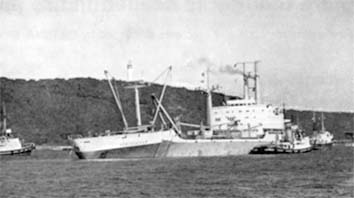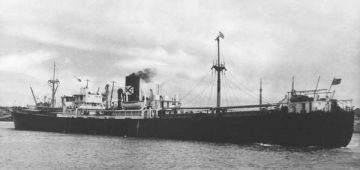The following are letters to the Editor published in the December 2014 issue.
From: Robin Burnett, Alfriston

It was good to see an article on the Ben Line Steamers in the August 2014 issue. These ships were particularly admired by those at sea for their distinctive appearance, not least the quality wood-grain effect painted steel panels of the accommodation.
I noted in particular the brief reference to the 12,902grt cargo ship Bencruachan, built on the Clyde in 1968, along with a photo of that ship, although she was not always so pristine in appearance.
In 1973 this ship drew worldwide attention to the dangers of freak waves when she was severely damaged while steaming into head seas and running before the Agulhas current (which can be 4-5 knots) south east of Durban. At the time, as editor of The Naval Architect and because of RINA’s concern over weather damage and the structural integrity of hulls, I took note of the details of the damage, weather conditions and oceanographic data.
In the early hours of 3rd May 1973, the 542ft Bencruachan was steering a course of 236 deg at 20 knots with an even draught of about 30ft. She was described in the ship’s log as rolling moderately, occasionally pitching heavily, and spraying overall in rough head seas, moderate to heavy SW swell with wind SW force 7.
At 0240hrs (SAST) according to the OOW she appeared to ’hit a solid mass’. The ship instantly lost way as a result of striking the freak wave. The whole 120ft long bow section to the break of the forecastle was bent down by 7 deg, side plating was compression buckled and opened to the sea in several places and all four decks and associated girders severely buckled abaft the bulkhead between Nos. 1 & 2 holds. The forecastle was awash, bulwarks abreast Nos. 1 & 2 hatches were carried away, No. 1 hatch coaming crushed and No. 2 hold flooded. Two deck containers were lost overboard and derricks were broken adrift, while the steel ladder on the foremast was twisted to a height of 40ft above deck.
Although there were no casualties the ship was in grave danger of breaking up and sinking but was almost certainly saved by the watertight bulkheads of the bunker tanks between the flooded No. 2 hold and No. 3 hold. Engine speed was reduced from 92rpm to 60rpm but attempts to turn the Bencruachan stern to wind failed and the engines were finally stopped at 0755. At 1300 a Dutch tug, Marjan III, took her in tow, stern first to Durban where she arrived at 1500 on 4th May, by then drawing 60ft forward and 27ft aft. After stabilising and temporary repairs in Durban the Benchruachan proceeded to Rotterdam where the bow and corrugated plating were cut off, and a new section was welded to the hull. The total cost of repairs amounted to about £1 million.
It was later concluded that freak, abnormal or rogue waves, as they may be called, can occur when the sinusoidal curves of different wave and swell trains become in-phase and these waves get much steeper when the wind is opposing a strong current, which in turn is effected by the topography of the continental shelf. It was also concluded that rogue waves were far more common than previously thought by the scientific community.

Long, heavily laden bulk carriers, are particularly vulnerable. The prime example of this was the 294m Derbyshire, the largest British registered ship ever to be lost at sea, sunk in 1980 with all hands in a typhoon off Japan. In 1997 the International Maritime Organization adopted new rules covering structural requirements for the survivability of bulk carriers upwards of 150m long, requiring double bottoms and bulkheads to be strong enough to withstand flooding of a hold. My book ‘Water under the Keel’ includes, on page 110, a photo of the Bencruachan (above), with her clearly bent bow section, under tow to Durban.
From: David Aris, by e-mail
From: Ifor Owen, Wellington, New ZealandRobin Burnett’s article (June 2014 issue) on the exploits of SS Empire Tide in convoy PQ 17 was most interesting and he mentions that the writer Godfrey Winn wrote, “the definitive and harrowing story of the convoy”, but in this book omitted any reference to the Empire Wave.
Well this may be the case but there are other books on this subject such as “The Arctic Convoys” by Vice Admiral Schofield, (ISBN 035401112X, 1977) and “Convoy” written in 1993, (ISBN 1860199690) by Paul Kemp both of which mention Empire Tide, especially Kemp’s book which relates in some detail the voyage to Archangel.
Whist Kemp’s book is not a definitive story of one particular Russian convoy, as it covers all the convoys, there and back, it does devote 2 chapters to convoy PQ17 and is very well researched.
Most appropriate that the photo of the Caledonia Star in the article on the London Docks in your June 2014 issue shows the 3 elevators for the mechanical meat discharge at ‘B’ berth Victoria Dock. This was a joint venture between the PLA and Blue Star Line for the handling of meat. It was conceived in 1964 but it was late1968 when the first trials were started. Unfortunately it did not get fully operational due to the advent of containerization.
Mechanical discharge of meat was first initiated by Blue Star in Liverpool, using banana conveyors in the early 1960s and after considerable experimentation was very successful. The London scheme was developed from the Liverpool system but was far more sophisticated. It was an all weather discharge with a computerised sorting system that coped with the complicated sorting requirements of the New Zealand meat trade.
Each elevator was connected to its own delivery area by a system of conveyor belts. The elevator discharged onto conveyors at the top floor of the shed and then across the roadway to ground level in an enclosed tunnel into a purpose built sorting area. This area was built parallel to the berth but on the opposite side of the road. The cargo was then transferred onto a conveyer belt which consisted of a series of 4 different coloured trays. Each coloured tray was controlled by an operator who identified the cargo on his tray – Mark and Grade – and this was entered into his keyboard.
The practice in manual discharge was that each truckload’s requirements were chalked onto the door by the tally clerk and carcasses delivered via handcarts from the landing area on the quay. Under the mechanical system each truckload and its outlet point was put on a punch card and fed into the computer. As the required cargo passed an outlet, the tray dropped and the carcass was then hand stowed in the truck. The outlets could be also used to feed cargo to rail wagons.The by pass system for cargo destined for barges was not built.

It was a good example of how the PLA co-operated with a shipping company to improve cargo handling but as mentioned earlier it was too late, with containers it was possible to load the distribution of requirements at the freezing works.




Comments
Sorry, comments are closed for this item